
In botany, a spadix is a type of inflorescence having small flowers borne on a fleshy stem. Spadices are typical of the family Araceae, the arums or aroids. The spadix is typically surrounded by a leaf-like curved bract known as a spathe. For example, the "flower" of the well known Anthurium spp. is a typical spadix with a large colorful spathe.
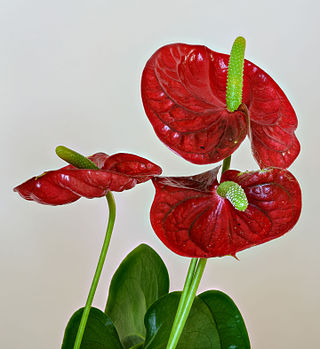
Anthurium is a genus of about 1,000 species of flowering plants, the largest genus of the arum family, Araceae. General common names include anthurium, tailflower, flamingo flower, and laceleaf.

Nicholas Edward Brown was an English plant taxonomist and authority on succulents. He was also an authority on several families of plants, including Asclepiadaceae, Aizoaceae, Labiatae and Cape plants.
Anthurium pallidiflorum is a species of plant in the family Araceae. It is endemic to Ecuador. Its natural habitat is subtropical or tropical moist lowland forests. It is threatened by habitat loss.

Anthurium andraeanum is a flowering plant species in the family Araceae that is native to Colombia and Ecuador. It is a winner of the Royal Horticultural Society's Award of Garden Merit.

The Living Rainforest is an indoor greenhouse tropical rainforest located in Hampstead Norreys in Berkshire, England. It is an ecological centre, educational centre and visitor attraction consisting of three glasshouses, operated and run by the Trust for Sustainable Living. The glasshouses are named Amazonica, Lowlands and Small Islands respectively.
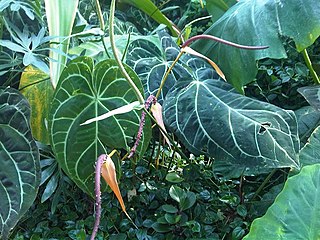
Anthurium crystallinum is a species of flowering plant in the family Araceae, native to rainforest margins in Central and South America, from Panamá to Perú. Growing to around 90 cm (35 in) tall and broad, A. crystallinum is an epiphytic perennial, characterised by large, velvety, ovate to heart-shaped leaves with prominent white veining; their blooms are somewhat visually insignificant inflorescences, with green spathes and pale green spadices, appearing throughout the year.

Anthurium clarinervium is a species of flowering plant is in the family Araceae native to Chiapas, Mexico. The Anthurium genus is known to contain approximately 1,000 species, resulting in one of the most diverse Central American tropical plant genera.

Anthurium warocqueanum, commonly known as the Queen Anthurium, is a species of plant in the genus Anthurium. Native to Colombia, it is grown in more temperate climates as a greenhouse specimen or houseplant for its ornamental foliage.
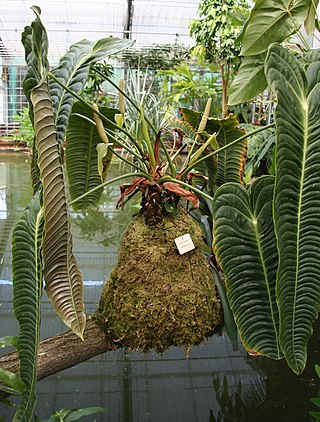
Anthurium veitchii, the king anthurium, is an epiphytic species of flowering plant in the genus Anthurium native to Colombia. It is grown in more temperate climates as a greenhouse or houseplant for its large, pendulous leaves that can be several feet long.

Anthurium pedatoradiatum or Anthurium Fingers is a species of plant in the genus Anthurium native to southern Mexico. A. pedatoradiatum has leaves with deep finger-like sections, and is terrestrial. Its natural habitat is from sea level up to 1,000 meters (3,300 ft) in the Mexican states of Veracruz, Tabasco, and Chiapas. It is related to other Anthurium in the section Schizoplacium such as Anthurium podophyllum, and its species name in Latin refers to the radiating growth of its palm-like leaves.
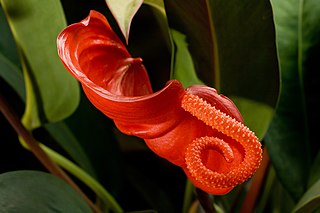
Anthurium scherzerianum, the flamingo flower or pigtail plant, is a species of Anthurium native to Costa Rica. It has gained the Royal Horticultural Society's Award of Garden Merit as an ornamental houseplant, kept at 15 °C (60 °F) or higher. It is naturally an epiphyte, growing on trees in the rainforest.

Anthurium magnificum is a plant in the genus Anthurium native to Colombia. Closely resembling other Anthurium species like Anthurium crystallinum, it has large, cordate leaves with prominent veining and is primarily terrestrial. Plants of the true species can be distinguished primarily by their quadrangular petioles.
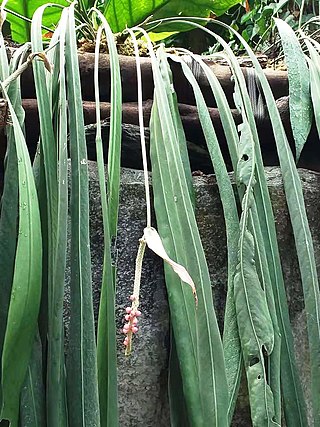
Anthurium vittariifolium is a species of flowering plant in the genus Anthurium native to the Amazon basin; southeast Colombia, Ecuador, Peru, and northern Brazil. With its long, pendulous leaves that can reach 2.4 m (8 ft), it is among those commonly known as "strap-leaved" anthuriums. It grows as an epiphyte at lower elevations of tropical moist forests, and is a member of the section Leptanthurium along with Anthurium gracile.

Anthurium amnicola, the tulip anthurium, tulip tailflower, or Hawaiian tulip, is a species of flowering plant in the family Araceae, native to Panama. With its tulip‑like flowers it was grown in Hawaii for the cut flower industry, and is occasionally sold today as a houseplant.
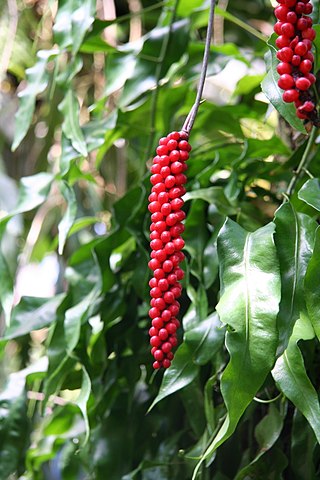
Anthurium gracile, the red pearls anthurium, is a species of flowering plant in the family Araceae, native to the American tropics. An epiphyte, when kept as a houseplant it needs excellent drainage.

Anthurium clidemioides is a species of plant in the genus Anthurium native to Costa Rica, Panama, and Colombia. One of the more distinctive Anthuriums, it is a vining climber with almost stalkless, bullate leaves that can range from light to very dark green. Along with Anthurium flexile it is one of only two species in the genus that produces roots between nodes.
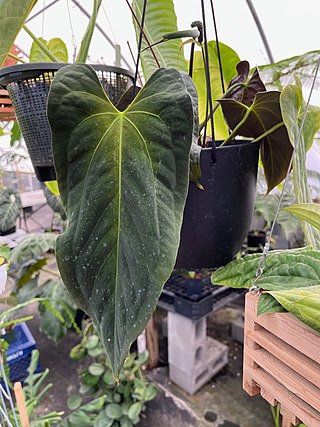
Anthurium papillilaminum is a species of plant in the genus Anthurium native to Panama. A. papillilaminum grows terrestrially and has very dark green cordate leaves on short stems. Its native range is very limited, with the species endemic to only the coasts of Colón Province and Darién Province up to 100 meters (330 ft) above sea level. A member of the section Cardiolonchium, it is closely related to other velvet-leaved Anthuriums, though it does not have silver veins on the leaves like Anthurium crystallinum.
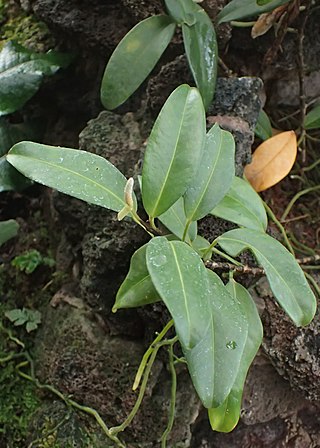
Anthurium scandens is a species of plant in the genus Anthurium. Native from Mexico to Southeast Brazil, it is the most widely distributed species of Anthurium in the Americas, and also extends to the Caribbean including Haiti, Puerto Rico, Jamaica, and other nations.

Anthurium podophyllum is a species of plant in the genus Anthurium native to coastal areas of the Mexican states of Veracruz and Oaxaca. A terrestrial species, it grows in tropical forest understories in seasonally dry areas. It is named for its palmate leaves that somewhat resemble plants in the (unrelated) genus Podophyllum, and which have many subdivisions. It is related to other terrestrial Anthurium with similar leaf morphology in the section Schizoplacium, such as Anthurium pedoradiatum, and produces orange berries.



















